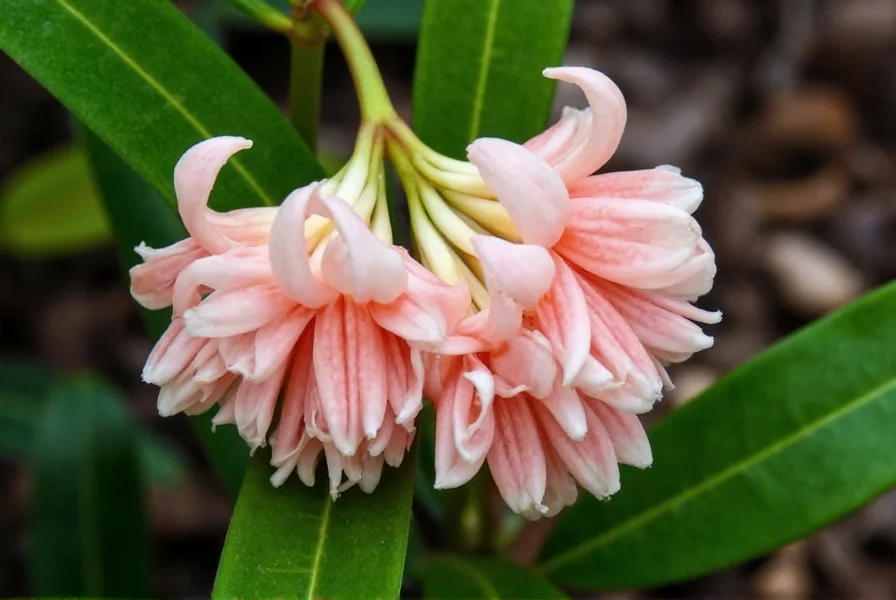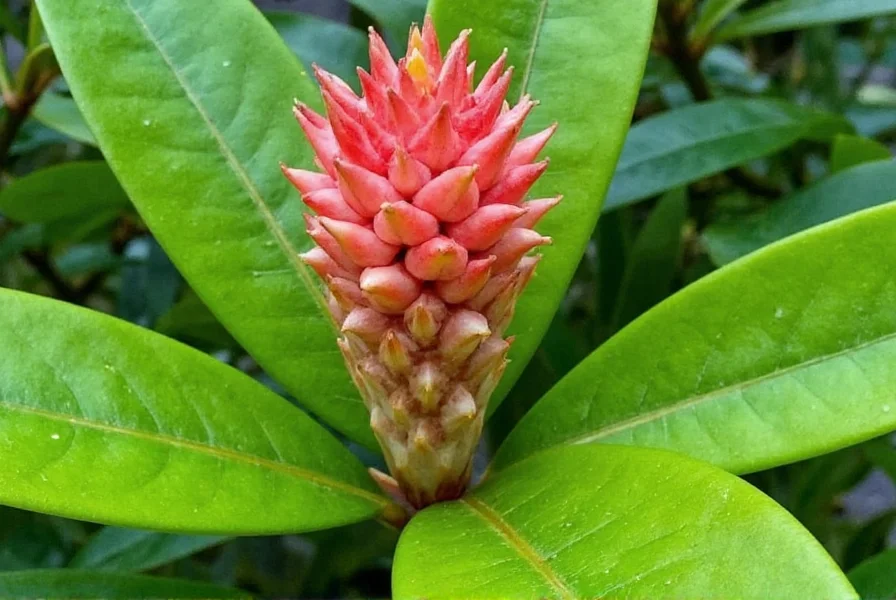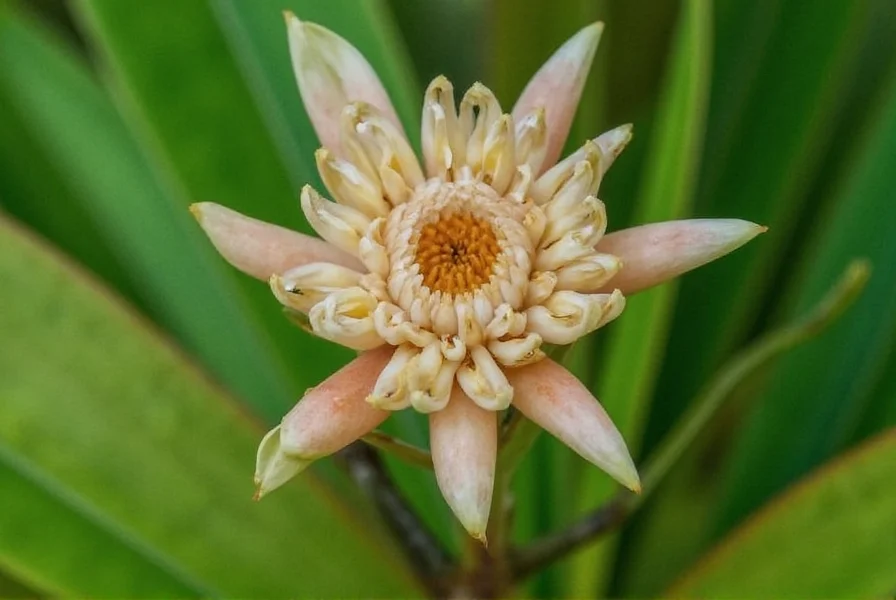Native to East Asia, shell ginger thrives in warm, humid environments and has become a popular choice for tropical and subtropical landscapes worldwide. This comprehensive guide explores everything you need to know about this distinctive plant, from identification to cultivation requirements.
Botanical Classification and Characteristics
Scientifically classified as Alpinia zerumbet, shell ginger belongs to the Zingiberaceae family, which includes approximately 50 species of Alpinia. The plant's common name comes from its unique flower structure, which resembles a delicate seashell when in bloom. Mature plants typically reach 6-12 feet in height with arching stems and long, lance-shaped leaves that can grow up to 24 inches long.
The most distinctive feature of shell ginger is its pendulous inflorescence, which produces white or pale yellow flowers with red-tipped stamens. These blooms appear in late spring through summer and are arranged in clusters that hang downward, creating a dramatic visual effect. The plant's rhizomes are aromatic but generally not used for culinary purposes like common ginger.

Natural Habitat and Growing Requirements
Originating from coastal regions of Japan, Taiwan, and southern China, shell ginger naturally grows in forest margins and along stream banks in partial shade. Understanding its native environment is crucial for successful cultivation.
| Growing Condition | Optimal Requirements | Tolerance Range |
|---|---|---|
| Temperature | 70-90°F (21-32°C) | Frost-sensitive; damaged below 32°F (0°C) |
| Light | Partial shade (2-4 hours direct sun) | Tolerates full shade but flowers less |
| Soil | Moist, well-draining, slightly acidic | Adaptable to various soil types if drainage adequate |
| Water | Consistently moist but not waterlogged | Drought-tolerant once established but prefers regular moisture |
Cultivation and Care Guidelines
Gardeners seeking to grow shell ginger successfully should consider several key factors. In USDA zones 8-11, this plant can grow outdoors year-round, while in cooler climates, it works well as a container plant that can be brought indoors during winter months.
When planting shell ginger, select a location with protection from strong winds, as its large leaves can tear easily. The ideal planting time is spring after the last frost. Space plants 3-5 feet apart to allow for proper air circulation and growth. Regular mulching helps maintain soil moisture and temperature while suppressing weeds.
Fertilization should occur during the active growing season (spring through summer) with a balanced, slow-release fertilizer. Avoid over-fertilizing, which can lead to excessive leaf growth at the expense of flowering. Pruning is minimal—simply remove dead or damaged leaves as needed to maintain plant health and appearance.
Propagation Methods for Shell Ginger
Successful propagation of shell ginger typically occurs through division of the rhizomes, which is best done in early spring before new growth begins. Gardeners interested in expanding their shell ginger collection should follow these steps:
- Dig up mature clumps carefully to avoid damaging rhizomes
- Divide rhizomes into sections with at least 2-3 growing points each
- Allow cut surfaces to dry for 24 hours to prevent rot
- Plant sections horizontally with growing points facing upward
- Water thoroughly after planting and maintain consistent moisture
While seed propagation is possible, it's less reliable and takes significantly longer for plants to reach maturity. For gardeners in cooler climates, container propagation allows for better control of growing conditions and easier overwintering.
Landscaping Applications and Design Considerations
Shell ginger's dramatic foliage and unique flowers make it an excellent choice for various landscape applications. Professional landscapers frequently incorporate this plant into tropical-themed gardens, woodland borders, and as a striking backdrop for lower-growing plants.
When designing with shell ginger, consider these effective applications:
- As a focal point in shaded garden areas where its glossy leaves catch available light
- Along property borders to create a lush, tropical screen
- Near water features where its natural affinity for moisture can be accommodated
- In container arrangements for patios and entryways in cooler climates
- As part of a layered planting scheme with varying heights and textures
For gardeners wondering how to grow shell ginger in tropical climates, the plant performs exceptionally well with minimal intervention once established. In subtropical regions, providing afternoon shade helps prevent leaf scorch during the hottest months.
Shell Ginger vs. Common Ginger: Key Differences
Many gardeners confuse shell ginger with common culinary ginger (Zingiber officinale), but several distinguishing characteristics set them apart:
- Flower structure: Shell ginger produces distinctive pendulous, shell-shaped flowers, while common ginger has more upright, cone-shaped inflorescences
- Rhizome use: Common ginger rhizomes are widely used in cooking and traditional medicine, whereas shell ginger rhizomes are primarily ornamental
- Leaf arrangement: Shell ginger has more arching stems with leaves arranged in two rows, creating a flatter profile
- Hardiness: Shell ginger generally tolerates slightly cooler temperatures than common ginger
- Height: Shell ginger typically grows taller (6-12 feet) compared to common ginger (2-4 feet)
Understanding these differences helps gardeners select the appropriate ginger variety for their specific needs, whether for ornamental landscaping or culinary purposes.
Potential Medicinal and Culinary Applications
While shell ginger is primarily grown as an ornamental plant, some traditional medicine systems have explored potential uses. Research on Alpinia zerumbet has identified various bioactive compounds in its leaves and rhizomes, including flavonoids and essential oils.
Unlike common ginger, which has well-documented culinary applications, shell ginger's rhizomes are not typically used in cooking due to their less pronounced flavor profile. However, some cultures use young shell ginger leaves in teas or as a flavoring agent. Gardeners curious about whether shell ginger is edible should note that while not toxic, it lacks the distinctive zing of culinary ginger and is best appreciated for its ornamental value.

Common Challenges and Maintenance Issues
Though generally low-maintenance, shell ginger can encounter several issues that affect its health and appearance. Understanding shell ginger plant care requirements helps prevent and address these problems:
- Leaf spot diseases: Fungal infections can cause brown spots on leaves, particularly in humid conditions with poor air circulation
- Root rot: Overwatering or poor drainage leads to rhizome decay—ensure proper soil conditions to prevent this issue
- Spider mites: These pests may appear in dry conditions, causing stippling on leaves and fine webbing
- Frost damage: In marginal climates, cold snaps can damage foliage—provide protection when temperatures drop
- Yellowing leaves: Often indicates overwatering or nutrient deficiency, particularly nitrogen
Regular inspection and proper cultural practices typically prevent most problems. For gardeners seeking effective shell ginger propagation methods, dividing healthy rhizomes from unaffected plants ensures disease-free new specimens.
Interesting Facts and Cultural Significance
Shell ginger holds cultural importance in several regions where it grows naturally. In Okinawa, Japan, where it's known as "getto," the leaves are sometimes used to wrap traditional foods. The plant's scientific name honors Prospero Alpini, a 16th-century Italian botanist who studied Egyptian flora.
One fascinating aspect of shell ginger is its ability to naturalize in suitable environments, sometimes becoming invasive in tropical regions like Hawaii and parts of Florida. Gardeners should monitor its spread in favorable conditions to prevent unwanted colonization of garden spaces.
Conclusion
Shell ginger (Alpinia zerumbet) offers gardeners a stunning tropical accent with relatively straightforward care requirements. By understanding its natural preferences and growth habits, you can successfully incorporate this beautiful plant into your landscape. Whether you're exploring how to grow shell ginger in tropical climates or seeking information about shell ginger plant care requirements, this versatile ornamental provides year-round interest with minimal maintenance when grown in appropriate conditions.
Frequently Asked Questions
Is shell ginger edible like common ginger?
While shell ginger (Alpinia zerumbet) is not toxic, it's primarily grown as an ornamental plant rather than for culinary use. Unlike common ginger (Zingiber officinale), shell ginger rhizomes lack the distinctive spicy flavor and are not typically used in cooking. Some cultures use young shell ginger leaves in teas, but it doesn't serve as a substitute for culinary ginger in recipes.
How much sun does shell ginger need to thrive?
Shell ginger prefers partial shade with 2-4 hours of morning sunlight. In its native habitat, it grows along forest margins where it receives dappled light. Too much direct sun, especially afternoon sun, can cause leaf scorch. In tropical climates, providing protection from intense midday sun ensures optimal growth and prevents foliage damage.
Can shell ginger survive winter in cooler climates?
Shell ginger is frost-sensitive and generally hardy only in USDA zones 8-11. In cooler climates (zones 7 and below), it can be grown as a container plant and brought indoors before the first frost. When overwintering shell ginger indoors, place it in a bright location with temperatures above 50°F (10°C) and reduce watering frequency while maintaining humidity.
How fast does shell ginger spread in the garden?
Shell ginger spreads moderately through its rhizomes, typically expanding 12-24 inches per year under optimal conditions. In tropical climates with year-round warmth and moisture, it may spread more aggressively and potentially become invasive. To control spread, install root barriers or divide plants every 2-3 years. Regular monitoring helps prevent unwanted colonization of garden spaces.
When does shell ginger typically flower?
Shell ginger typically flowers from late spring through summer, with peak blooming occurring in June and July in most climates. The pendulous flower clusters appear at the ends of stems and feature white or pale yellow blossoms with distinctive red-tipped stamens. Flowering is most abundant on mature plants (3+ years old) grown in partial shade with consistent moisture.











 浙公网安备
33010002000092号
浙公网安备
33010002000092号 浙B2-20120091-4
浙B2-20120091-4